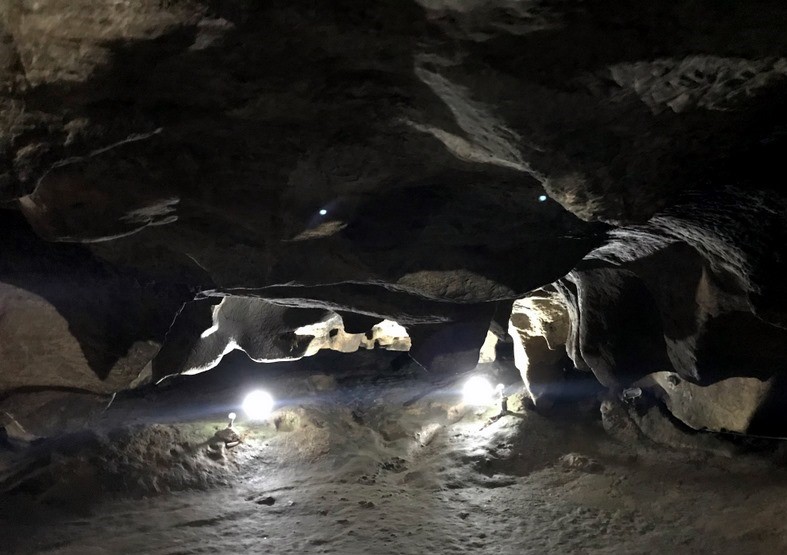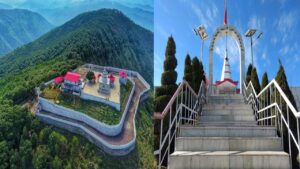Patal Bhuvaneshwar Cave Temple-The Eternal Beauty and Spiritual

Patal Bhuvaneshwar Cave Temple also known as Patal Bhuvaneshwar Mandir,is a magnificent underground shrine located in the Kumaon region of Uttarakhand, India. This ancient temple is situated at an elevation of 1350 meters above sea level and is nestled amidst the dense forests of the Himalayas. The temple is dedicated to Lord Shiva and is believed to be one of the holiest places in India.
Patal Bhuvaneshwar Cave Temple is an underground cave temple that has been carved out of limestone rock by the forces of nature over millions of years. The temple is said to have been discovered by King Rituparna of the ancient kingdom of Ayodhya during his exile. According to legend, the cave system leads to the underworld, where Lord Shiva is said to reside.
The temple is known for its unique rock formations and intricate carvings that depict various deities and mythological scenes. The main entrance of the cave is a narrow tunnel that leads to a large chamber, known as the Garbhagriha. The chamber houses a Shivalinga, which is the main deity of the temple.
The cave system is believed to be over 400 meters long and has several other chambers, each with its own significance. The most famous of these chambers is the Sita Baug, which is believed to be the place where Sita, the wife of Lord Rama, meditated during her exile. Another chamber is the Dhyan Kutia, which is said to be the place where the great saint Ved Vyas meditated and wrote the Mahabharata.
Visitors to the temple must climb down a steep staircase to reach the entrance of the cave. Inside the cave, the temperature is cool and pleasant, providing a welcome respite from the heat and humidity of the Indian plains. The temple is open to visitors throughout the year, but the best time to visit is between the months of March and June.
Patal Bhuvaneshwar Cave Temple is not only a place of worship but also a popular tourist destination. The temple’s unique architecture, ancient history, and spiritual significance make it a must-visit destination for anyone traveling to the Kumaon region of Uttarakhand.

Patal Bhuvaneshwar View
The view of Patal Bhuvaneshwar Cave Temple is truly magnificent and breathtaking. The temple is located in a serene and picturesque location amidst the lush green forests of the Himalayas. The entrance to the temple is a narrow tunnel that leads to a large chamber, which houses the main deity of the temple, Lord Shiva.
The chamber is adorned with intricate carvings of various deities and mythological scenes, and the ceiling is covered with stalactites and stalagmites, which have formed over millions of years. As visitors make their way through the cave system, they will come across several other chambers, each with its own unique features.
The Sita Baug chamber is a particularly beautiful chamber, with a natural spring flowing through it and a garden of flowers surrounding it. The Dhyan Kutia chamber is another remarkable chamber, with a large stalagmite that is said to represent Lord Shiva.
The entire cave system is illuminated with soft lighting, which adds to the enchanting ambiance of the temple. The cool and refreshing air inside the cave provides a welcome relief from the heat and humidity of the surrounding area.
As visitors make their way out of the temple, they are treated to a panoramic view of the surrounding mountains and forests. The temple is located in a secluded area, and the view from the top is truly breathtaking.
Overall, the view of Patal Bhuvaneshwar Cave Temple is a mesmerizing and unforgettable experience. The combination of natural beauty, ancient history, and spiritual significance make it one of the most unique and remarkable destinations in India.
History of Patal Bhuvaneshwar: Tracing the Temple’s Origins
The history of Patal Bhuvaneshwar Cave Temple is shrouded in mystery and myth. According to Hindu mythology, the cave system was first discovered by the legendary King Rituparna of the ancient kingdom of Ayodhya. It is believed that he stumbled upon the entrance to the cave while on a hunting expedition.
Over time, the cave system became a place of worship for devotees of Lord Shiva. It is believed that the temple was built by the Pandavas during their exile, and later it was renovated by the Katyuri Kings of the Kumaon region.
The Katyuri Kings were a powerful dynasty that ruled over the Kumaon region from the 7th to the 12th century. They were great patrons of art, culture, and architecture and are credited with the construction of many remarkable temples and buildings in the region. It is believed that the Katyuri Kings were responsible for the current design and architecture of the Patal Bhuvaneshwar Cave Temple.
In the 14th century, the temple came under the control of the Chand Kings of Kumaon. The Chand Kings were a powerful dynasty that ruled over the Kumaon region for over 300 years and were great patrons of the arts and architecture. They further embellished the temple and added several new features, including the beautiful carvings and intricate artwork that can be seen inside the temple today.
During the British colonial period, the temple came under the control of the British government, who declared it a protected monument. In 1993, the temple was handed over to the Archaeological Survey of India for preservation and maintenance.
Today, Patal Bhuvaneshwar Cave Temple is considered one of the most important historical and spiritual landmarks in the Kumaon region of Uttarakhand. The temple attracts thousands of devotees and tourists every year who come to witness the magnificent beauty and rich history of this ancient cave temple.
Legends and Mysteries of Patal Bhuvaneshwar: The Enchanting Depths
Patal Bhuvaneshwar Cave Temple is steeped in legends and mysteries that add to its enchanting allure. The cave system is believed to be one of the holiest places in India, and many devotees believe that a visit to the temple can grant them blessings and good fortune.
One of the most intriguing legends associated with the temple is that it is the abode of Lord Shiva and his divine consort, Parvati. It is believed that the entrance to the temple is guarded by a serpent, and only those who are deemed worthy by the serpent are allowed to enter.
Another legend associated with the temple is that it is the place where the five Pandava brothers, heroes of the Hindu epic, the Mahabharata, meditated during their exile. It is believed that the Pandavas sought refuge in the cave system to escape the wrath of their enemies, and Lord Shiva granted them protection and blessings.
The cave system is also believed to have a mystical energy that can heal and purify the body and soul. Many devotees come to the temple to seek spiritual enlightenment and to cleanse themselves of negative energies.
Another mystery associated with the temple is the presence of a small stream of water that flows through the cave system. The water is believed to have healing properties, and many devotees come to the temple to bathe in the holy waters.
Despite centuries of exploration and study, the cave system continues to hold many secrets and mysteries. Its ancient history and spiritual significance continue to attract visitors from all over the world who are captivated by its enchanting depths.
Overall, Patal Bhuvaneshwar Cave Temple is a fascinating and mystical place that offers a glimpse into the ancient history and spiritual traditions of India. Its legends and mysteries add to its enchanting allure and make it one of the most unique and remarkable destinations in the country.
The Architecture and Design of Patal Bhuvaneshwar: A Marvel of Engineering
The architecture and design of Patal Bhuvaneshwar Cave Temple is a marvel of engineering and artistic skill. The temple is carved out of the natural rock formation, and the intricate carvings and sculptures within the temple are a testament to the remarkable craftsmanship of the ancient artisans who built it.
The entrance to the temple is a narrow opening in the ground that leads down a steep staircase into the cave system. The cave system is made up of a series of chambers and passageways, and each chamber has a unique feature or sculpture that is dedicated to Lord Shiva and other deities of Hindu mythology.
One of the most remarkable features of the temple is the natural formation of the cave system. The cave walls are adorned with stunning stalactites and stalagmites that have formed over thousands of years, creating a natural wonder that is breathtaking to behold.
The intricate carvings and sculptures within the temple are also a remarkable feat of artistic skill. The walls of the temple are adorned with beautiful carvings of Lord Shiva, Parvati, and other deities of Hindu mythology. The sculptures are intricately detailed and show remarkable skill and precision.
The design of the temple is also a remarkable feat of engineering. The temple is designed in such a way that it remains cool and pleasant throughout the year, even during the hot summer months. The natural air conditioning system of the temple is created by the flow of air through the cave system, which keeps the temperature inside the temple at a comfortable level.
Overall, the architecture and design of Patal Bhuvaneshwar Cave Temple are a remarkable testament to the skill and ingenuity of the ancient artisans who built it. The temple is a unique and remarkable destination that offers a glimpse into the rich history and artistic traditions of India.
How to Reach
Patal Bhuvaneshwar Cave Temple is located in the district of Pithoragarh in the northern Indian state of Uttarakhand.
Here are the ways to reach Patal Bhuvaneshwar:
- By Air: The nearest airport is Pantnagar Airport, which is located about 215 kilometers from Patal Bhuvaneshwar. From the airport, you can hire a taxi or take a bus to reach Patal Bhuvaneshwar.
- By Train: The nearest railway station is Kathgodam Railway Station, which is located about 160 kilometers from Patal Bhuvaneshwar. From the railway station, you can hire a taxi or take a bus to reach Patal Bhuvaneshwar.
- By Road: Patal Bhuvaneshwar is well connected by road, and you can easily reach there by taking a bus or hiring a taxi from major cities in Uttarakhand such as Dehradun, Haridwar, Rishikesh, Nainital, Almora, and Pithoragarh.
The road to Patal Bhuvaneshwar passes through picturesque landscapes, scenic valleys, and beautiful hill stations, making the journey a memorable one. However, the road leading to the temple is narrow and winding, and it is advisable to hire a local driver who is familiar with the terrain to ensure a safe and comfortable journey.
Overall, reaching Patal Bhuvaneshwar is an adventure in itself, and the scenic beauty of the region makes the journey an unforgettable experience.
Munsiyari to Patal Bhuvaneshwar Distance
The distance between Munsiyari and Patal Bhuvaneshwar is approximately 155 kilometers. The road distance can take around 6-7 hours, as the route passes through narrow and winding roads of the mountainous terrain. It is advisable to hire a local driver who is familiar with the terrain to ensure a safe and comfortable journey. The road from Munsiyari to Patal Bhuvaneshwar is very scenic and offers breathtaking views of the Himalayas, making the journey an unforgettable experience.
Jageshwar to Patal Bhuvaneshwar
The distance between Jageshwar and Patal Bhuvaneshwar is approximately 105 kilometers. The road distance can take around 4-5 hours, as the route passes through narrow and winding roads of the mountainous terrain. It is advisable to hire a local driver who is familiar with the terrain to ensure a safe and comfortable journey. The road from Jageshwar to Patal Bhuvaneshwar is very scenic and offers breathtaking views of the Himalayas, making the journey an unforgettable experience.
Patal Bhuvaneshwar distance from Nainital
The distance between Nainital and Patal Bhuvaneshwar is approximately 160 kilometers. The road distance can take around 6-7 hours, as the route passes through narrow and winding roads of the mountainous terrain. It is advisable to hire a local driver who is familiar with the terrain to ensure a safe and comfortable journey. The road from Nainital to Patal Bhuvaneshwar is very scenic and offers breathtaking views of the Himalayas, making the journey an unforgettable experience.
Patal Bhuvaneshwar Cave open time
The Patal Bhuvaneshwar Cave Temple is open to visitors from 6:00 AM to 6:00 PM every day. However, it is advisable to check the timings before planning a visit as there may be changes in the opening and closing timings during certain festivals or events. Also, due to its remote location and narrow roads, it is better to plan the visit during daylight hours. It is recommended to check with the temple authorities or local tourism office for the latest information on the opening and closing timings and any other guidelines for visiting the temple.
Patal Bhuvaneshwar Cave mystery
Patal Bhuvaneshwar cave temple has long been associated with various legends and mysteries. According to folklore, the cave system leads to the underworld, where Lord Shiva is believed to reside. Many people believe that the cave system is connected to other underground caves and tunnels that stretch for miles beneath the surface of the earth.
Another mysterious aspect of the temple is the presence of an underground river that flows through the Sita Baug chamber. This river is said to be connected to the Ganga river and is considered to be extremely sacred. The water of the river is believed to have healing properties, and many people come to the temple to bathe in the holy waters.
There are also stories of hidden treasure and secret passages within the cave system. Some people believe that the temple was built by the Pandavas during the Mahabharata era and that they hid their treasure in the caves. Others believe that there are secret passages that lead to other parts of the temple or even to other temples in the region.
Despite the many legends and mysteries surrounding Patal Bhuvaneshwar cave temple, it remains a popular place of worship and a major tourist destination. The temple’s unique history, stunning architecture, and beautiful surroundings continue to captivate visitors from all over the world.
Things to do in Patal Bhuvaneshwar Temple
Patal Bhuvaneshwar Temple offers a unique spiritual and adventurous experience.
Here are some things to do in Patal Bhuvaneshwar Temple:
- Visit the Cave Temple: The main attraction of Patal Bhuvaneshwar Temple is the cave temple. Explore the intricate rock formations and the religious significance of the temple. The cave is filled with natural stalactites and stalagmites that create beautiful formations.
- Take a Dip in the Holy Water: There is a holy pond inside the temple complex where you can take a dip to purify your soul. The pond is believed to have healing powers and can cure various ailments.
- Attend Aarti: Attend the evening aarti (prayer ceremony) at the temple. It is a peaceful and spiritual experience that will leave you feeling refreshed and rejuvenated.
- Trek to the Waterfall: Trek to the nearby waterfall, which is a popular tourist attraction. The trek is easy and the waterfall is a serene and beautiful spot for a picnic.
- Explore the Surrounding Caves: There are several caves around the Patal Bhuvaneshwar Temple that are worth exploring. The most famous is the Guptkashi cave, which is believed to be the hiding place of Lord Shiva during the great flood.
- Enjoy Local Cuisine: Try the local cuisine at the small restaurants near the temple. The food is simple and delicious, and will give you a taste of the local culture.
- Go Bird Watching: Patal Bhuvaneshwar Temple is surrounded by dense forests and is home to several species of birds. Go bird watching and spot some rare and exotic birds.
- Take Part in Adventure Activities: Patal Bhuvaneshwar Temple is also a popular destination for adventure activities like rappelling, rock climbing, and trekking. Take part in these activities and add some thrill to your trip.
Conclusion:
Patal Bhuvaneshwar Cave Temple is not only a remarkable natural wonder but also a significant spiritual site. Its unique geological formation, stunning stalactites and stalagmites, and underground stream make it a must-visit destination for nature lovers and adventure seekers.
Moreover, the temple’s association with Hindu mythology and its sacredness as a site of worship add to its spiritual significance. It is believed that a visit to Patal Bhuvaneshwar can purify one’s soul and provide relief from the cycle of birth and death.
The mystery surrounding the cave, particularly the unexplained rock formations and carvings, only adds to its allure. Despite the scientific attempts to understand the geological and anthropological aspects of the cave, it remains shrouded in mystery, leaving visitors in awe of its beauty and spiritual significance.
Overall, Patal Bhuvaneshwar Cave Temple is a testament to the wonders of nature and the richness of Hindu mythology. It is a unique destination that has something to offer for everyone, from adventure enthusiasts to spiritual seekers, making it a must-visit destination in India.








